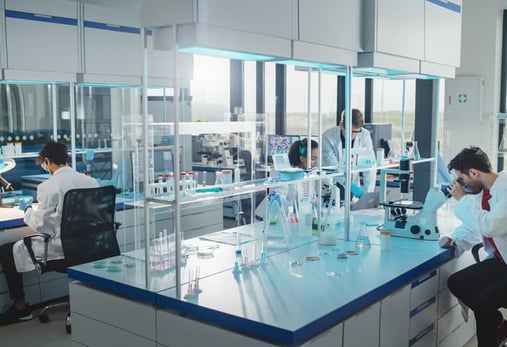As organizations increasingly focus on energy conservation as a means of reducing costs and achieving sustainability initiatives, EHS experts are often asked to review the laboratory's general airflow plan for air changes per hour (ACH).
An example of a cost-saving adjustment to ACH in general office spaces is the recirculation of a percentage of the air from/to the same interior space. While this can save money on heating and cooling costs, all indoor air in a laboratory is single pass. Single pass air handling drives up the cost of heating and cooling lab spaces because it requires 100% fresh air from the outside, with no recirculation processes.
Safety Partners indicates that many legacy labs are operating at 8-12 ACH and some may be attempting to save money by reducing airflow during non-work hours. Other facility managers try to reduce ACH in general. But - what IS a safe level of ACH for laboratory environments?
Calculating your lab's ACH
First things first: Although an HVAC specialist can calculate this using a variety of tools, you can use this formula to figure out your space's air changes per hour: IACH = 60Q / Volume.
Q in this formula is the volumetric flow rate of air in cubic feet per minute (CFM)—usually the CFM of the filtration device being used.
The ACH is 60 multiplied by the CFM of your air exchange device, divided by the volume of air in the room
It's important to remember that ventilation and air change rates are calculated on a per-person basis. It follows then, that when the number of people in a given space doubles, the needed air rate change doubles as well. Your HVAC system has to be able to handle the variable occupancy and activity levels of your laboratory spaces.
ASHRAE's Recommendations
The ACH required for the operation of "safe" lab spaces is not as easily determined as your ACH rate. Factors to be considered include the type of work being done, whether there are the appropriate source point ventilation controls and the direction of airflow. These considerations become even more difficult when protecting your occupants from SARS-CoV-2 viruses and other pathogens. Recently, both the World Health Organization (WHO) and the Center for Disease Control (CDC) have released statements recognizing the potential for airborne transmission of aerolized particles.
Per ASHRAE, initially laboratory environments were considered extremely low risk because these facilities are typically designed with 100% of the indoor air exhausted to the atmosphere, higher ACH rates and exhaust systems specifically designed to eliminate the reintroduction of contaminated air.
Specific mitigation strategies are required to minimize the transmission of aerolized particles within a space. This is made more challenging because strategies that may work for other facility types absolutely cannot be used in laboratories due to their impact on air flow patterns within the lab and the performance of existing containment devices.
In September 2021 ASHRAE published guidelines for HVAC mitigation strategies unique to the lab environment. These guidelines also detail strategies that may NOT work well in laboratories.
As with other elements of a well run facility, before implementing any changes to any of the systems within the laboratory, consult with experienced Life Sciences facility professionals to evaluate any mitigation strategies and their impact on other systems. DENS' Life Sciences experts can help identify opportunities to help make your lab spaces operate more efficiently and sustainably, with the safety of your occupants front-of-mind.

Blog Comments